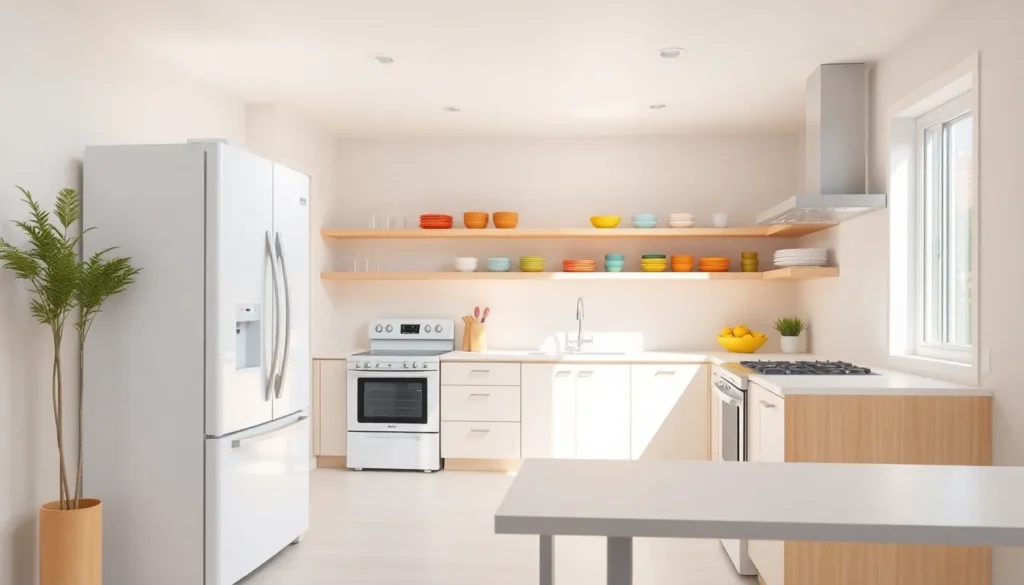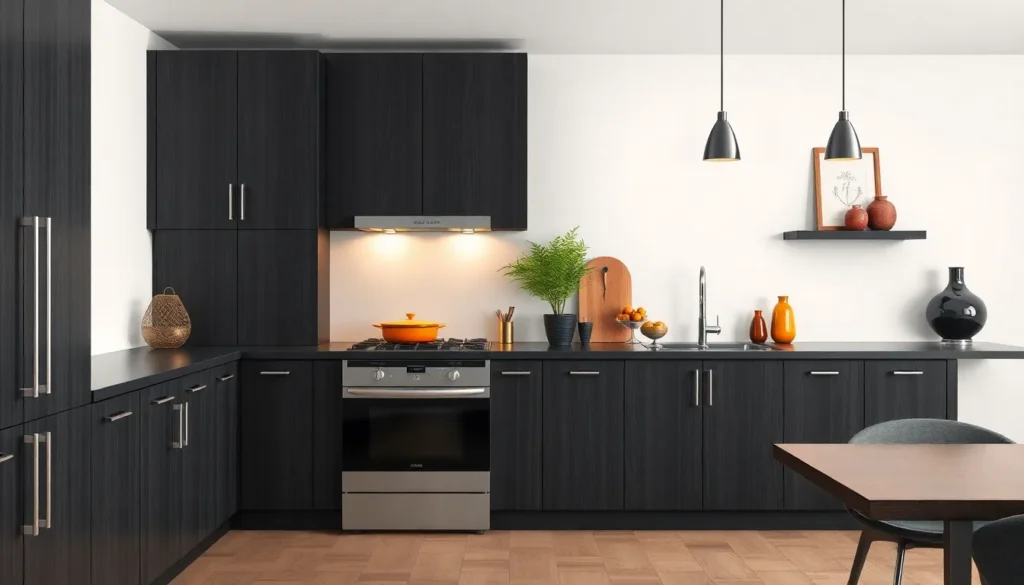Imagine a world where your coffee brews itself while you snooze, and your fridge knows when you’re out of milk. Welcome to the smart home appliances market, where technology meets convenience in the most delightful ways. As homes get smarter, these gadgets are not just a luxury; they’re quickly becoming a necessity for the modern lifestyle.
With the rise of IoT (Internet of Things), smart appliances are revolutionizing the way people live, making everyday tasks easier and more efficient. From voice-activated assistants to refrigerators that can order groceries, the possibilities are endless. Dive into this exciting market and discover how these innovative devices are transforming homes into futuristic havens, one gadget at a time. Who knew that upgrading your home could be this much fun?
Table of Contents
ToggleOverview of Smart Home Appliances Market
Smart home appliances represent a rapidly growing segment of the consumer electronics industry. The integration of these devices with the Internet of Things (IoT) creates a seamless user experience. By leveraging connectivity, smart appliances can communicate with one another, enhancing functionality and convenience.
Global market trends indicate a significant increase in demand for smart devices. In 2022, the market for smart home appliances reached approximately $80 billion, and projections suggest it could surpass $150 billion by 2027. This growth reflects changing consumer preferences as people seek to increase energy efficiency and simplify daily tasks.
Home automation systems stand out for their ability to provide control over various household functions. Products such as smart thermostats, lighting systems, and security cameras not only improve comfort but also increase safety and security. Voice-activated devices further contribute by allowing hands-free operation for various tasks.
Investment in technology plays a crucial role in shaping the smart home landscape. Manufacturers continuously innovate by incorporating artificial intelligence and machine learning, enhancing device responsiveness and user interaction. For instance, smart refrigerators can automatically adjust temperatures or suggest meal ideas based on stock levels.
Consumer awareness remains a driving force in this market. As education around smart technology increases, adoption rates also rise. People often prioritize seamlessly integrating smart appliances into their lives, with features like remote monitoring and automation appealing to various demographics.
The smart home appliances market thrives on technology advancements, increasing consumer demand, and ongoing engagement with IoT innovations. The expansion of this industry signifies a fundamental shift in how daily life unfolds within households, making modern living more efficient and intuitive.
Key Drivers of Market Growth

Several factors contribute to the growth of the smart home appliances market. Recognition of technological advancements and consumer demands for convenience plays a crucial role.
Technological Advancements
Innovation in technology significantly drives market expansion. Integration of IoT fosters seamless connectivity between devices. Enhanced features such as remote control and automation streamline user experiences. Moreover, advancements in artificial intelligence allow for personalized settings based on user habits. Smart devices increasingly incorporate voice recognition, making interactions effortless. This combination of cutting-edge technology and user-friendly interfaces enhances overall appeal.
Consumer Demands for Convenience
Consumer preferences for convenience influence market dynamics. An increasing number of households prioritize time-saving solutions, fostering growth in smart home appliances. Modern lifestyles require appliances that simplify daily tasks, leading to higher adoption rates. Features like app control and energy efficiency resonate with consumers seeking effective home management. Additionally, the emphasis on enhanced safety through smart security systems increases consumer confidence. As awareness of these conveniences spreads, more consumers embrace the benefits, driving market growth even further.
Major Players in the Smart Home Appliances Market
Leading manufacturers in the smart home appliances market are driving innovation and expansion. Companies such as Amazon, Google, and Samsung play pivotal roles in this rapidly growing sector.
Company Profiles
Amazon dominates the smart home space with products like Echo and its Alexa virtual assistant. Google provides strong competition through its Nest devices, which offer seamless integration with Google Assistant. Samsung focuses on smart appliances that feature SmartThings technology, allowing users to control devices from their smartphones. LG emphasizes energy efficiency and connectivity with its ThinQ platform, enhancing user experiences in home automation. Other notable companies include Philips with its Hue lighting systems and Bosch, known for smart kitchen solutions.
Market Share Analysis
The smart home appliances market reached approximately $80 billion in 2022, with forecasts suggesting it will exceed $150 billion by 2027. Amazon captured roughly 30% of the market share due to its extensive ecosystem and brand loyalty. Google follows closely with a 20% share, driven by its strong integration of smart devices. Samsung, holding around 15% market share, attracts users through highly compatible appliances. Emerging startups and smaller companies make up the remaining share, fostering a competitive landscape that encourages continuous innovation and growth.
Trends Shaping the Future of Smart Home Appliances
The smart home appliances market is evolving rapidly, driven by technology and consumer preferences. Innovations continue to enhance user experiences across various demographics.
Integration with IoT
Integration with IoT remains a key trend that shapes the smart home appliances landscape. Devices communicate seamlessly, allowing users to control systems remotely. Voice-activated assistants play a crucial role, enabling hands-free operation and simplifying daily tasks. Smart refrigerators now automatically reorder groceries and track inventory. Interconnected devices enhance functionality by creating a cohesive smart home environment. Global adoption rates continue to rise as consumers recognize the convenience of IoT technology. Approximately 75% of consumers express interest in smart home solutions. The ongoing evolution of IoT ensures that appliances remain relevant and responsive to user needs.
Sustainability and Energy Efficiency
Sustainability and energy efficiency are significant factors influencing the smart home appliances market. Consumers increasingly prioritize eco-friendly technologies that reduce energy consumption. Smart thermostats, for instance, optimize heating and cooling based on user behaviors, leading to lower utility bills. Energy-efficient appliances help consumers reduce their carbon footprint while providing cost savings. Major brands are innovating sustainable solutions, enhancing their product lineups with energy-efficient certifications. Approximately 60% of consumers consider energy efficiency when purchasing smart home devices. As eco-consciousness grows, manufacturers shift focus toward integrating sustainability in their designs, shaping a greener future for home automation.
Challenges Facing the Smart Home Appliances Market
The smart home appliances market encounters several challenges that could impact its growth trajectory. Addressing these obstacles is essential for companies seeking to maintain a competitive edge.
Security Concerns
Security concerns plague smart home devices, posing risks to user privacy and safety. Consumers worry about potential hacking incidents that could lead to unauthorized access to personal information. According to surveys, approximately 70% of consumers remain hesitant to adopt these technologies due to data security fears. Manufacturers focus on encryption and authentication as critical measures to safeguard user data. Any lapse in security could thwart consumer trust, making it vital for companies to prioritize robust security features.
Interoperability Issues
Interoperability issues hinder the seamless integration of various smart devices within households. Different brands often employ incompatible technologies and protocols, complicating user experiences. Research indicates that around 65% of consumers desire devices from different manufacturers to work together harmoniously. Standardization across platforms could enhance usability and attract more homeowners. Efforts to develop universal protocols remain crucial for favoring interoperability in an increasingly connected market. Companies that commit to these enhancements can foster greater consumer confidence and encourage wider adoption.
The smart home appliances market is on a remarkable trajectory driven by technological advancements and evolving consumer preferences. As more households embrace automation and connectivity, the demand for innovative solutions continues to grow. Major players are at the forefront of this transformation, pushing boundaries to enhance user experiences and sustainability.
While challenges like security concerns and interoperability remain, the industry’s response through improved safety measures and standardization is promising. The future of smart home appliances looks bright as they become integral to everyday life, making homes not just smarter but also more efficient and secure. Embracing these technologies will undoubtedly redefine modern living for generations to come.









